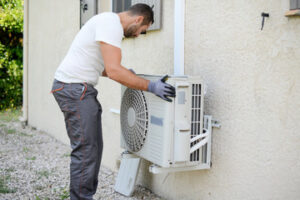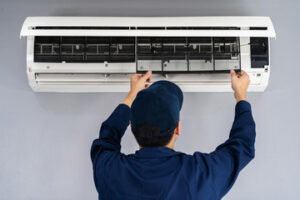AC repair is the process of returning an air conditioning system to working condition. It can reduce energy bills, improve indoor air quality, and protect a warranty.

If your breaker keeps tripping, check for a clogged filter or an outside unit that’s blocked by weeds, grass, and vines. These are both do-it-yourself jobs. Contact Kool Zone Air Conditioning & Heating, LLC for professional help.
Air filters are a vital part of your HVAC system. They slot right into the duct compartments and force circulating air to pass through them, cleaning out dust, pollen, mold spores, pet dander and other pollutants.
When the filter is dirty, however, it restricts airflow and forces the AC to work harder to cool your home. As such, a dirty filter can increase energy bills and shorten the lifespan of your HVAC system.
The best way to avoid such problems is by regularly replacing your air filter. You can purchase disposable filters from most home improvement stores for as little as $0.50 each. Washable filters cost a bit more but can save you money in the long run by cutting down on waste and prolonging the life of your HVAC system.
You can also invest in HEPA-rated filters that remove a higher percentage of the most microscopic airborne pollutants. These are often recommended for households with allergy or asthma sufferers, and they can improve overall indoor air quality significantly.
In addition to improving occupant health, a clean air filter can reduce the spread of bacteria and viruses. The filtration process reduces the pathways for germs to circulate in a home, which is especially helpful for houses with elderly or immunocompromised occupants.
A dirty, low-quality filter increases the amount of stale air that circulates in a home and can cause a number of other problems. For example, a dirty filter can contribute to visible dirt build-up on surfaces around the house and exacerbate allergies or asthma flare-ups in household members.
A dirty air filter can also make it hard for your HVAC system to cool your home, which causes the refrigerant level in the AC unit to drop. This leads to inefficient operation and potential damage to other components like the evaporator coil or condenser coil.
Refrigerant Levels
Refrigerant is a vital component of your AC system, and maintaining adequate levels of this chemical is crucial to ensuring optimal performance and longevity. A low refrigerant level forces the compressor to work harder to cool your home, which can lead to premature failure and expensive repair bills. Promptly addressing low refrigerant levels is a simple way to reduce your energy bill and prolong the lifespan of your unit.
If you suspect your air conditioner is low on refrigerant, it’s important to contact a professional for assistance. The process of assessing and replenishing refrigerant requires specialized tools and safety protocols, which can only be handled by a certified technician. Additionally, attempting to handle refrigerant without proper training could lead to personal injury and violating environmental regulations.
Insufficient refrigerant can cause the evaporator coil to freeze over, which limits airflow and further hampers cooling efficiency. Additionally, ice accumulation can also harm the compressor and other system components, leading to costly repairs. Low refrigerant levels can also indicate a leak, which can cause further damage to your air conditioning system and result in an even higher energy bill.
Low refrigerant levels can lead to frequent short cycling, which occurs when your air conditioner turns on and off frequently before reaching the desired temperature. Frequent cycling can cause premature wear and tear on your system, requiring a replacement sooner than expected.
To check your refrigerant level, turn off the power to your air conditioner and remove the cover from the outdoor unit. Locate the service ports for the liquid line (blue) and high-pressure suction line (red). Connect your refrigerant pressure gauge to the red service port on the liquid line and the blue gauge to the high-pressure suction line. Read the pressure reading on the gauges and compare them to the manufacturer’s recommended specifications. If the levels are low, add refrigerant following the instructions in your owner’s manual.
Electrical Connections
The network of wires that connect the electrical components of your AC unit is complicated. Many HVAC technicians use circuit diagrams or other visual guides to keep track of it all. However, the wiring can become damaged due to a number of factors.
A wire can break or become disconnected, leading to short circuits or voltage drops that can damage your equipment. It can also become loose due to improper splicing or poor cable connections.
Another common cause of wiring problems is corrosion, which can lead to exposed wires. This can be particularly dangerous for your AC unit, since the system uses high levels of electricity to operate. If you notice any signs of corrosion, contact an AC repair technician immediately.
Most air conditioning units use a combination of 240-volt and 120-volt wires to connect the indoor and outdoor units. The higher voltage is required to power the AC unit’s control board and other parts, while the lower voltage wires are used to connect the outdoor unit and evaporator coils.
Your electrical system is protected by fuses and voltage regulators to prevent unsafe conditions. Fuses are located on the distribution board and are matched to the size of the expected current for each circuit (group). Over time, a fuse will burn out when too much current passes through it. This is an indication that your AC system is overtaxing the wiring and that it’s time to replace the fuse.
If you open up your access panel and see a burned fuse, it’s important to replace the fuse before restarting your system. Burned fuses indicate that the system has been receiving too much voltage, which could result in permanent damage to your air conditioner.
Before replacing the fuse, make sure that all the wiring is in good condition. Check for frayed wires, split casings and signs of pests, like chewed wires. Also look for signs of corrosion on the connections and disconnect box. If you find any of these issues, have a professional replace the old disconnect box and reconnect the low voltage wiring with new Romex wire.
Thermostat
The thermostat is an important component of the AC system that allows it to accurately sense temperature levels. It is responsible for sending signals to the air conditioning unit that tell it when to start and stop working in order to achieve a desired indoor climate. A number of problems with the thermostat can cause inaccurate temperature readings, leading to inefficient AC performance and higher energy bills.
One of the most common thermostat issues is the fact that it doesn’t correctly read the current indoor temperature. When the thermostat is located in direct sunlight, near a drafty window or other heat-generating appliances, it may misread the actual room temperature and send faulty signals to the air conditioner. This can lead to the system running longer than necessary in an attempt to reach a target temperature, which wastes energy and causes wear on the HVAC unit.
Another common problem with thermostats is that they may fail to respond at all, whether due to a wire connection issue or a physical breakdown. A loose or disconnected wire can interrupt communication between the thermostat and the air conditioning system, making it impossible for the system to turn on or off as needed. A skilled technician can make the necessary wire connections or repairs to restore full functionality to the thermostat.
Sometimes a thermostat can become dirty inside, causing it to provide inaccurate temperature readings. Keeping the area around the thermostat clean can prevent this from happening, although it is best to leave any kind of cleaning to professionals to avoid voiding the warranty and damaging the unit.
Depending on the type of thermostat you have in your home, it might require special cleaning and maintenance to keep it functioning properly. It is also essential to consult the user manual to ensure you have the right type of thermostat installed in your home. If you try to install a different type of thermostat than what your home currently has, it could cause problems that will require costly repair or replacement. For this reason, it is always best to let a professional choose and install your thermostat.
